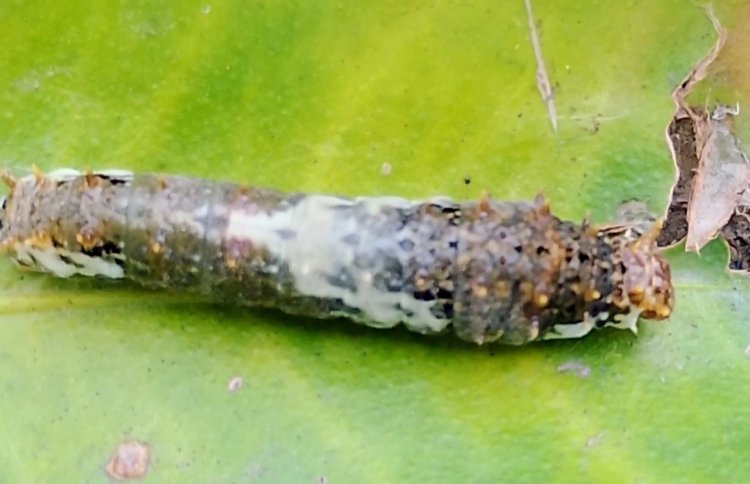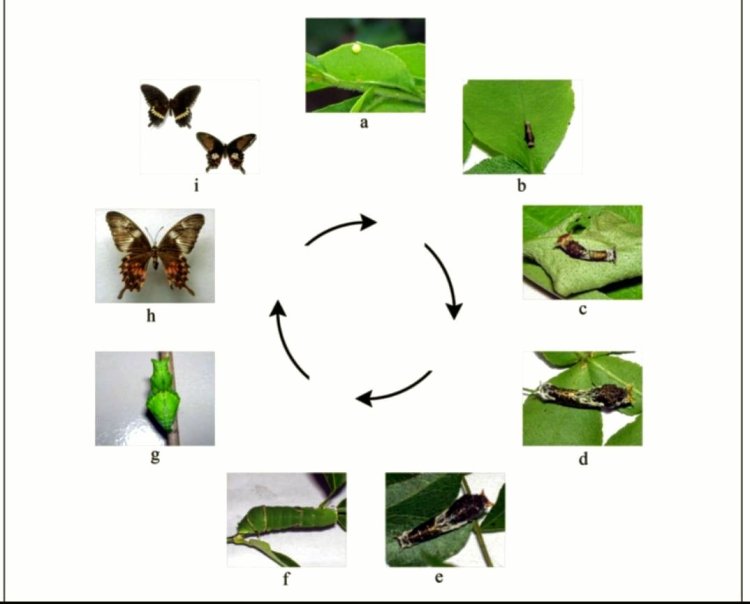Orange dog or Orange puppy
Giant Swallowtail caterpillar (Papilio cresphontes), also commonly known as an "orange dog" or "orange puppy" caterpillar due to its primary host plants being citrus trees.
The leaf it is on appears to be a citrus leaf, which is a typical food source for this species.

Appearance and Mimicry: Young Giant Swallowtail caterpillars have a remarkable camouflage that mimics bird droppings, providing protection from predators. They are typically dark brown or black with prominent white or creamy markings, especially a "saddle" pattern in earlier instars. As they mature, their coloration shifts to a mottled dark brown with cream-colored markings, and later instars are sometimes said to resemble small snakes.
Host Plants: These caterpillars primarily feed on the leaves of plants in the citrus family (Rutaceae), including orange, lemon, lime, and grapefruit trees. They also feed on other Rutaceae like prickly ash and rue.
Defense Mechanism: When disturbed or threatened, the caterpillar can evert a pair of fleshy, horn-like orange glands from behind its head called an osmeterium. This organ releases a foul-smelling substance, acting as a deterrent to small predators like ants and spiders, although it may not deter birds.
Life Cycle
The Giant Swallowtail undergoes a complete metamorphosis, involving four distinct stages:
Egg Stage: Females lay small, round, cream to brownish-rust colored eggs individually on the upper surface of host plant leaves, primarily citrus trees or plants from the rue family. Eggs hatch in about 4-10 days, depending on temperature.
Larval (Caterpillar) Stage: The hatched larvae are the "orangedogs" that feed on citrus leaves.

Early Instars: Younger caterpillars are dark brown or black with white or creamy markings, effectively mimicking bird droppings for camouflage.
Mature Larvae: As they grow, they turn green with white or pink markings and may develop "eyespots." When threatened, they can evert an orange osmeterium, releasing a foul odor. This stage typically lasts a few weeks.
Pupal Stage (Chrysalis): The mature caterpillar attaches itself to a branch or other surface and forms a chrysalis. The chrysalis is typically brown or green and resembles a twig, providing camouflage. This stage can last from two to three weeks, but can extend for months in colder climates where they overwinter in this form.
Adult Butterfly Stage: The adult butterfly emerges from the chrysalis, characterized by its large size and striking black and yellow markings. Adults feed on nectar and are primarily focused on reproduction.
Control Management for Giant Swallowtail Caterpillars
While Giant Swallowtails are beneficial pollinators in their adult stage, their caterpillars can defoliate young citrus trees. Control measures are often focused on preventing significant damage to vulnerable plants.
Preventive Measures:
Early Planting: Mature citrus trees are more resilient and can better withstand some defoliation than young trees.
Monitor Young Growth: Female butterflies prefer to lay eggs on new, lighter-colored leaves, so regularly inspecting these areas for eggs and young caterpillars is crucial for early detection.
Mechanical/Cultural Control:
Handpicking: On small trees or in home gardens, manually removing and destroying eggs and caterpillars can be an effective control method.
Encourage Natural Enemies: Promote a healthy garden ecosystem that attracts natural predators like birds and parasitic wasps, which prey on caterpillars.
Biological Control:
Bacillus thuringiensis (Bt): This naturally occurring bacterium specifically targets caterpillars and is safe for other organisms. It can be sprayed on leaves and ingested by the caterpillars, leading to their demise.
Parasitic Insects: In commercial settings, introducing specific parasitic insects like Trichogramma chilonis (egg parasitoid) or encouraging larval parasitoids can help manage populations.
Chemical Control (Use with caution):
Targeted Insecticides: In cases of severe infestation on young, vulnerable trees, insecticides like spinosad or pyrethroids can be considered. However, use them judiciously to minimize impact on beneficial insects and pollinators.
Neem Products: Neem-based products, like Neem Seed Kernel Extract (NSKE) or Azaditachtin, can act as antifeedants and repellents against citrus butterfly larvae.
Note: For mature, established citrus trees, minor defoliation by Giant Swallowtail caterpillars usually does not warrant extensive intervention, as the trees can tolerate some leaf loss.
What's Your Reaction?
















